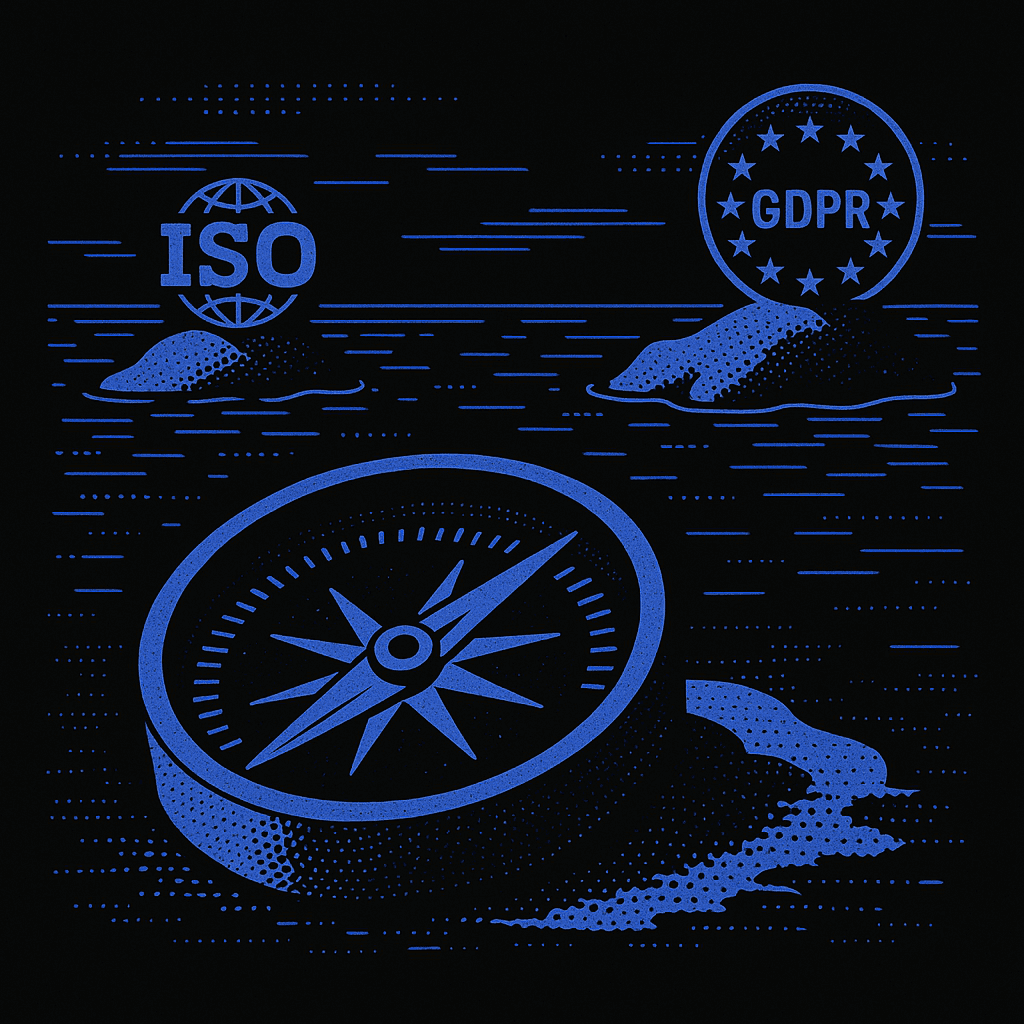TL;DR
Windsurf AI IDE provides SOC 2 Type II certification, but enterprise AI coding assistant selection requires deployment-based security patterns addressing specific infrastructure and compliance constraints. Seven alternatives emerge for organizations requiring capabilities beyond basic cloud certification, including ISO/IEC 42001 AI governance, air-gapped deployment, hybrid architectures, platform compliance inheritance, complete infrastructure control, and regulated industry specialization.
Critical finding: Research reveals developers using AI tools take 19% longer to complete tasks despite believing they work 24% faster, requiring sophisticated oversight and realistic expectations about productivity gains.
Enterprise Security Gaps Blocking AI Adoption
Enterprise AI coding assistants face procurement rejection despite basic compliance certifications due to specific security gaps creating regulatory and operational risks.
Missing Customer-Managed Encryption Keys (CMEK): 73% of enterprises in regulated industries require cryptographic control over encryption keys for HIPAA, PCI-DSS, and data sovereignty compliance. Standard solutions lacking CMEK cannot meet requirements for immediate data access revocation.
Incomplete Air-Gapped Deployment: Defense contractors and classified environments require zero external connectivity. Traditional hybrid models requiring cloud compute connectivity fail security review in air-gapped scenarios.
Limited Compliance Scope: Platform-level SOC 2 certification without explicit product inclusion in scope statements creates procurement barriers. European enterprises requiring ISO 27001 for vendor approval may require remediation from vendors lacking certification.
Package Hallucination Risks: AI-generated references to non-existent software libraries create supply chain attack vectors that security researchers warn could create monitoring blind spots for attackers to exploit.
Production Quality Degradation: Teams using AI tools deploy 20-30% more code but experience measurable quality degradation without corresponding review process scaling, masking underlying efficiency problems.
These gaps create distinct security patterns requiring specialized solutions.
1. AI Governance with CMEK (Augment Code)
What it is
AI governance-certified coding assistant combining ISO/IEC 42001 certification with customer-managed encryption keys and zero-training policies for enterprises requiring regulatory compliance and cryptographic control.
Why it works
First AI coding assistant achieving ISO/IEC 42001 certification from Coalfire provides responsible AI governance framework. CMEK support enables controlled encryption key revocation and satisfies regulated industry requirements for data custody. Zero-training policy on proprietary code minimizes intellectual property exposure risk.
Implementation approach
Week 1: Request SOC 2 Type II attestation report, verify ISO/IEC 42001 certificate, review Data Processing Addendum
Week 2: Configure customer-managed encryption keys through Enterprise Tier, implement key rotation policies, test encryption key revocation
Week 3-4: Deploy 200,000-token context window, configure SSO integration and MFA, implement audit logging and SIEM integration
Infrastructure needs: Enterprise Tier licensing, Key Management Service compatibility, network connectivity for API access, SSO infrastructure (SAML 2.0, OIDC)
When to choose
Organizations requiring ISO/IEC 42001 AI governance certification, CMEK for regulated industries, or verified third-party attestations from SOC 2 Type II compliance.
2. Air-Gapped Infrastructure Control (Tabnine Enterprise)
What it is
Code completion platform supporting enterprise-grade deployments, including fully air-gapped environments through Kubernetes architecture. Note that while Tabnine markets enterprise-grade compliance, ISO 27001 certification is not publicly verified as of late 2025.
Why it works
Complete architectural flexibility from SaaS to fully air-gapped deployment addresses security requirements across enterprise environments. Zero-retention architecture with Kubernetes deployment provides enterprise-grade scalability without external connectivity requirements.
Implementation approach
Week 1: Assess Kubernetes cluster requirements (16+ cores, 64+ GB RAM), plan network isolation, obtain licensing and container images
Week 2-3: Deploy MicroK8S cluster, configure Helm charts for private installation, implement network security groups and firewall rules
Week 4: Configure SAML 2.0 SSO and SCIM 2.0 provisioning, test air-gapped functionality, implement monitoring and audit logging
Infrastructure needs: Kubernetes cluster, 16+ CPU cores, 64+ GB RAM minimum, 200+ GB SSD storage, air-gapped network capability
When to choose
Organizations requiring air-gapped deployment capabilities, flexible identity management integration, or existing Kubernetes infrastructure. Note that ISO 27001 certification should be verified directly with vendor.
3. Hybrid Architecture with Zero-Retention (Codeium Enterprise)
What it is
Enterprise AI coding assistant with SOC 2 Type II certification and hybrid deployment architecture supporting zero-data retention policies through architectural separation of data and compute layers.
Why it works
Hybrid architectures enable data layer deployment on customer infrastructure while leveraging cloud compute resources. Zero-data retention addresses compliance requirements, though verification of mathematical enforcement versus policy-based implementation requires direct vendor confirmation.
Implementation approach
Week 1: Design data layer infrastructure, plan network connectivity to Codeium compute layer, configure customer-controlled data storage
Week 2: Deploy customer-controlled code storage, configure remote indices for context awareness, implement zero-retention architecture
Week 3: Establish secure connectivity to Codeium GPU infrastructure, configure ephemeral processing, test hybrid data flow and retention guarantees
Infrastructure needs: Customer data layer infrastructure, network connectivity to Codeium compute, VMware VCF compatibility, independent SOC 2 compliance validation
When to choose
Organizations requiring SOC 2 Type II certification with zero-data retention guarantees, hybrid deployment models, or certified technology partnerships.
4. Platform Compliance Inheritance (GitHub Copilot Enterprise)
What it is
Enterprise AI coding assistant with SOC 2 Type 1 and ISO/IEC 27001:2013 certification providing comprehensive policy management and audit capabilities within the GitHub platform.
Why it works
Comprehensive audit logging with optional IP address disclosure provides compliance visibility. Centralized policy enforcement enables consistent management of Copilot features across enterprises. Platform compliance inheritance from GitHub simplifies security review processes.
Implementation approach
Week 1: Access SOC 2 Type 1 reports, verify ISO/IEC 27001:2013 certification scope, review platform compliance model
Week 2: Configure IP allow-listing for private assets, implement subscription-based network routing, set up firewall rules
Week 3: Enable centralized policy enforcement, configure audit logging with IP disclosure, implement OIDC integration
Infrastructure needs: GitHub Enterprise Cloud or Server, network firewall configuration, OIDC identity provider, audit log storage and SIEM integration
When to choose
Organizations accepting managed cloud deployment with SOC 2 Type 1 compliance, requiring comprehensive audit logging, and needing enterprise governance with subscription-based access controls. Note that SOC 2 Type 1 differs from Type II in compliance rigor.
5. Complete Infrastructure Control (Azure OpenAI)
What it is
Azure OpenAI services configured for enterprise AI-assisted coding with complete data custody through private networking and compliance inheritance from Azure platform certifications.
Why it works
Private endpoint VNet integration provides strong network isolation within virtual networks. Compliance inheritance from Azure's SOC 2 Type 2 and ISO/IEC 27001:2022 certifications reduces security review complexity. Azure landing zone architecture ensures structured governance and security controls.
Implementation approach
Week 1-2: Deploy Azure landing zones with management and connectivity infrastructure, configure platform landing zones for governance
Week 3: Create private endpoints for Azure OpenAI resources, configure VNet integration and DNS resolution, implement network security groups
Week 4: Install GitHub Copilot or Azure OpenAI extensions, configure private connectivity through Azure backbone, test AI-assisted coding workflows
Infrastructure needs: Azure subscription with landing zone architecture, Virtual Network with private endpoint subnet, Azure Policy enforcement, GitHub Copilot or Azure OpenAI extension licensing
When to choose
Organizations requiring complete data custody through private networking, Azure ecosystem integration, established cloud security review processes, and SOC 2 Type 2 compliance through platform inheritance.
6. Regulated Industry Focus (IBM watsonx Code Assistant)
What it is
Enterprise AI coding assistant designed for regulated industries with platform-level compliance inheritance, on-premises deployment options for specific variants, and optional AI governance integration.
Why it works
Platform-level SOC 2 Type 2 certification from IBM watsonx infrastructure provides an established compliance foundation. On-premises deployment available for specific variants (watsonx Code Assistant for Z, Red Hat Ansible Lightspeed) addresses air-gapped requirements. Optional watsonx.governance integration provides explainability and regulatory reporting.
Implementation approach
Week 1: Verify platform-level SOC 2 Type 2 certification scope, assess product-specific compliance requirements, plan governance integration
Week 2-3: Choose between cloud, on-premises, or hybrid deployment, configure Cloud Pak for Data infrastructure
Week 4: Configure watsonx.governance for explainability and monitoring, implement model health tracking, set up compliance reporting automation
Infrastructure needs: Cloud Pak for Data, Kubernetes/OpenShift for air-gapped deployment, watsonx.governance licensing (separate product), IBM Cloud infrastructure or self-hosted environment
When to choose
Organizations with existing IBM infrastructure, regulated industry compliance requirements, need for optional AI governance integration, and acceptance of platform-level compliance inheritance model.
Implementation Decision Framework
If regulatory compliance is primary constraint: Augment Code provides dual ISO/IEC 42001 and SOC 2 Type II certifications with CMEK support for regulated industries requiring AI governance frameworks and cryptographic control.
If air-gapped deployment is mandatory: Tabnine Enterprise supports comprehensive air-gapped deployment through Kubernetes architecture and zero external connectivity requirements, though certification documentation should be verified directly.
If managed cloud deployment is acceptable: GitHub Copilot Enterprise provides comprehensive policy enforcement, audit logging, and network access controls without self-hosted infrastructure requirements.
If complete infrastructure control is priority: Azure OpenAI with landing zone architecture provides private endpoint connectivity, compliance inheritance, and secure deployment within centrally managed virtual networks.
If mathematical data guarantees are required: Codeium Enterprise provides architectural zero-retention through data/compute layer separation, with enterprise deployment options on VMware infrastructure.
If regulated industry specialization is needed: IBM watsonx Code Assistant provides platform compliance with optional governance integration and on-premises variants for specific use cases.
Critical Implementation Considerations
The Productivity Paradox: Research reveals developers using AI tools take 19% longer to complete tasks despite believing they work 24% faster. This 43-percentage-point perception gap requires sophisticated oversight and realistic expectations.
Security Monitoring Gaps: Organizations lack monitoring capabilities to track AI-generated code, creating exposure where security vulnerabilities or malicious package hallucination could occur undetected. Success requires dedicated security scanning infrastructure.
Quality vs Speed Tradeoffs: Teams experience quality degradation without corresponding review process scaling, even as they report perceived productivity gains. AI assistants require more senior oversight, not fewer engineering resources.
Compliance Documentation Verification: Multiple vendors demonstrate platform-level certifications without product-specific attestation scope statements. Regulated industry procurement requires explicit service inclusion verification through direct vendor engagement.
Choosing the Right Security Pattern
Enterprise AI coding assistant selection requires deployment-based security patterns addressing specific compliance, infrastructure, and governance constraints beyond basic SOC 2 certification. The six patterns provide concrete implementation paths for organizations requiring capabilities standard solutions cannot deliver.
Ready to implement enterprise-grade AI with verified security? Try Augment Code with ISO/IEC 42001 certification, CMEK support, and SOC 2 Type II compliance. Experience AI governance designed specifically for regulated industries with cryptographic control over your encryption keys.
Related Resources
Security Comparisons:
Privacy Comparison of Cloud AI Coding Assistants
How Developers Protect Code Privacy with AI
Enterprise Adoption:
Building Business Cases for Enterprise AI Platforms
How to Scale AI Adoption Beyond Initial Pilots
Compliance Guides:
SOC 2 Type 2 for AI Development
HIPAA-Compliant AI Coding Guide
Tool Comparisons:
Molisha Shah
GTM and Customer Champion

